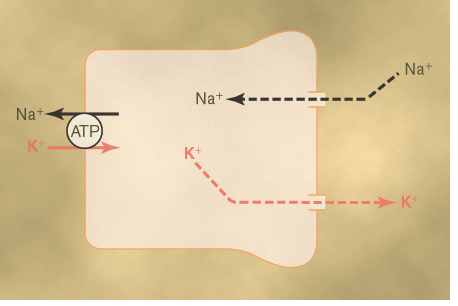
Renal Regulation of Potassium, Calcium, Phosphate, and Magnesium; Integration of Renal Mechanisms for Control of Blood Volume and Extracellular Fluid Volume
Extracellular fluid potassium concentration normally is regulated at about 4.2 mEq/L, seldom rising or falling more than ±0.3 mEq/L. This precise control is necessary because many cell functions are sensitive to changes in extracellular fluid potassium concentration. For instance, an increase in plasma potassium concentration of only 3 to 4 mEq/L can cause cardiac arrhythmias, and higher concentrations can lead to cardiac arrest or fibrillation.Extracellular fluid calcium ion concentration normally remains tightly controlled within a few percentage points of its normal level, 2.4 mEq/L. When calcium ion concentration falls to low levels (hypocalcemia), the excitability of nerve and muscle cells increases markedly and can in extreme cases result in hypocalcemic tetany. This condition is characterized by spastic skeletal muscle contractions. Hypercalcemia (increased calcium concentration) depresses neuromuscular excitability and can lead to cardiac arrhythmias.
In discussing the regulation of extracellular fluid volume, we consider the factors that regulate the amount of sodium chloride in the extracellular fluid because changes in extracellular fluid sodium chloride content usually cause parallel changes in extracellular fluid volume,provided the antidiuretic hormone (ADH)-thirst mechanisms are operative. When the ADH-thirst mechanisms are functioning normally, a change in the amount of sodium chloride in the extracellular fluid is matched by a similar change in the amount of extracellular water, and thus maintenance of osmolality and sodium concentration is relatively constant.
At the end of the lesson, students will understand;
REGULATION OF EXTRACELLULAR FLUID POTASSIUM CONCENTRATION AND POTASSIUM EXCRETION
CONTROL OF RENAL CALCIUM EXCRETION AND EXTRACELLULAR CALCIUM ION CONCENTRATION
INTEGRATION OF RENAL MECHANISMS FOR CONTROL OF EXTRACELLULAR FLUID
DISTRIBUTION OF EXTRACELLULAR FLUID BETWEEN THE INTERSTITIAL SPACES AND VASCULAR SYSTEM
NERVOUS AND HORMONAL FACTORS OF RENAL–BODY FLUID FEEDBACK CONTROL
CONDITIONS THAT CAUSE LARGE INCREASES IN EXTRACELLULAR FLUID VOLUME BUT WITH NORMAL BLOOD VOLUME


